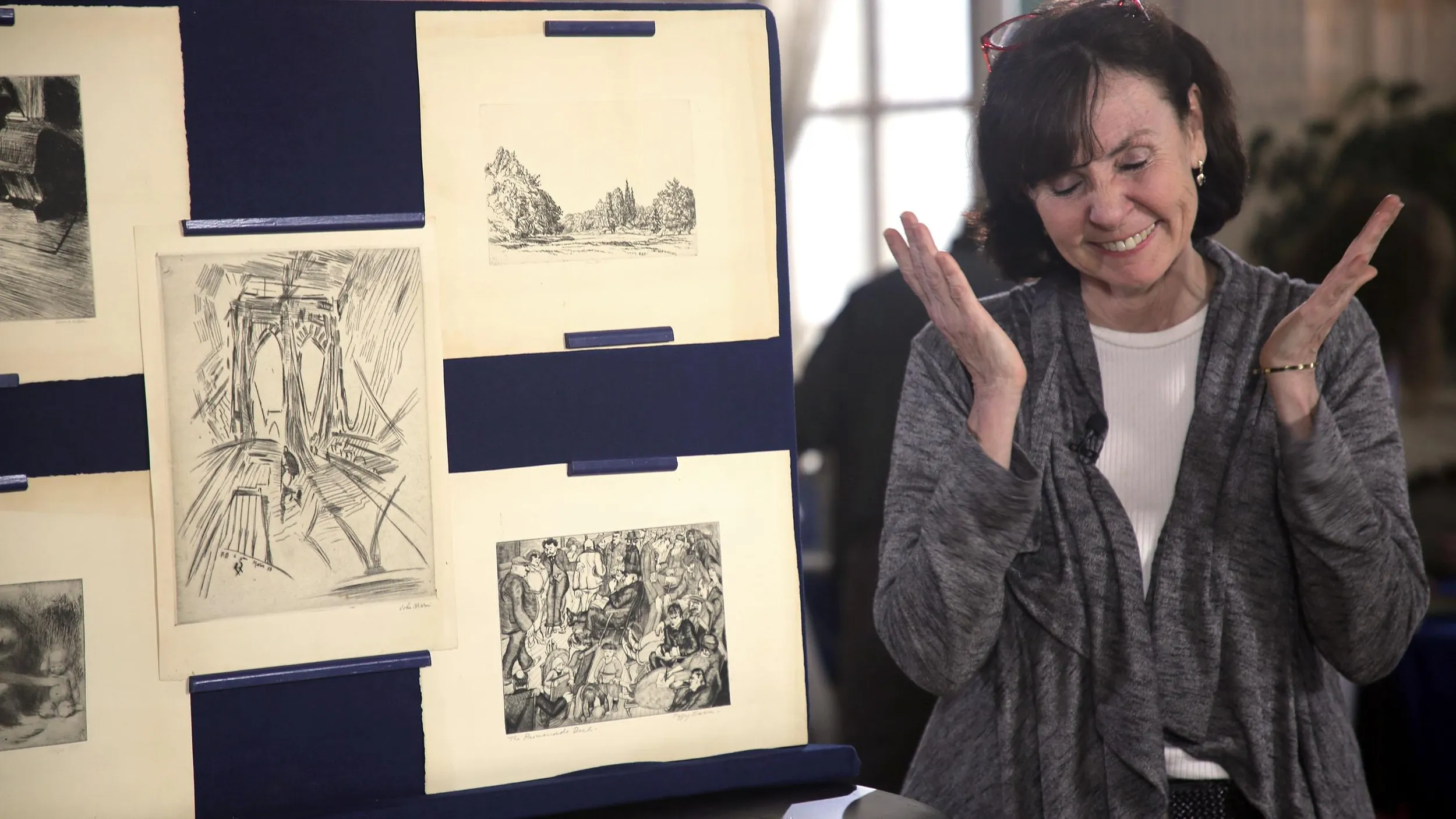GUEST: During the Depression, my aunt was, started buying up these vases from Tiffany's, so I guess she ordered some by the crate-load.
APPRAISER: It actually says, "Louis C. Tiffany Studios," with an address. The crate in itself, it's something you don't see very often, with "glass" plastered all over the sides. But I also want to point out the straw.
GUEST: (chuckles)
APPRAISER: Because it's not often that people keep the shipping crates. The first piece of glass over here, which is what we would call pastel glass...
GUEST: Mm-hmm.
APPRAISER: Is later-production Tiffany-- it was made in the '20s.
GUEST: Okay.
APPRAISER: It was made in multiples, and it came in different colors. These are the colors that you see in some of the Depression glass of the era...
GUEST: Mm-hmm.
APPRAISER: But this was a lot more expensive than your average piece of Depression glass. Now, this piece is a paperweight glass vase.
GUEST: Mm-hmm.
APPRAISER: Leslie Nash, who worked for Louis Comfort Tiffany, claims that while they were working with paperweight glass, Louis Tiffany himself, who was a painter, came into the glass-working shop, handed them a painting of morning glories that he had painted, and said, "I want you to make this in glass."
GUEST: Wow.
APPRAISER: Supposedly, it took $12,000 in R&D...
GUEST: Mm-hmm.
APPRAISER: to create this kind of glassware. 1914 is when they first introduced it. Your piece, on the bottom, actually says "exhibition piece" on it. I know from the date letter, which is a suffix L, that that would be somewhere around 1915.
GUEST: Okay.
APRAISER: So it's possible that this could've gone to the 1915 San Francisco International Exhibition. I think it came back to the studios, that's the interesting part. You may have seen vases like this. They're in many museums all over the world.
GUEST: I think I saw one at the Met in New York, mm-hmm.
APPRAISER: Yes, and the one at the Met has a number on the bottom, which is 1130-L. Yours is 1132-L. Oh. So this is two numbers after the Met's vase.
GUEST: Okay.
APPRAISER: The Met acquired it in 1924, even though it was probably made in 1915. So these things still were sold later. The crate, in a retail setting, this is something for Tiffany geeks everywhere-- collectors, museums. They would actually be very excited about this, and it would be worth between $5,000 and $10,000.
GUEST: Holy cow!
APPRAISER: This piece, which is not as sought-after as some of the other art glass...
GUEST: Mm-hmm.
APPRAISER: would retail probably between $2,000 and $3,000. But this piece, in a retail shop, it could be sold for anywhere between $50,000 and $75,000.
GUEST: No way! Oh, my gosh! I was... thinking maybe $8,000 to $10,000, I was hoping. Wow.
APPRAISER: Well, that was a long time ago.
GUEST: Wow, I really didn't know what the market had done, you know, if it had gone sideways or up or down, but... wow. (inhales)
APPRAISER: So there's one other thing in here that I want to talk about. This vase. This practically stopped my heart when I saw it in the box. (giggling) This is the piece I was waiting for for 20 years.
GUEST: Oh, wow.
APPRAISER: And every night before the ROADSHOW, people would always say, "What is on your wish list? What would you like to come in to the show tomorrow?" And I always say, "A Tiffany Lava vase."
GUEST: Wow.
APPRAISER: And that's what this is. It's extremely special. It is meant to look like molten lava...
GUEST: Mm-hmm.
APPRAISER: on the surface of the vase, and this one is particularly interesting because you also have these protrusions here. It's very similar to a vase that was shown in the 1906 Paris Salon Exhibition.
GUEST: Oh!
APPRAISER: A very similar example is in the collection of the Musèe des Arts Dècoratifs in Paris, and it's been there since 1906.
GUEST: Gee.
APPRAISER: So when I saw this... I was kind of excited. (laughing)
GUEST: Oh.
APPRAISER: The thing about Lava is, it was very hard to make. They get cracked in the making.
GUEST: Oh.
APPRAISER: And I did go over your Lava with my special light and a magnifying glass, and I couldn't find any imperfections. An example like this, in a retail shop, could sell between $100,000 and $150,000.
GUEST: (laughing) Where's my brother? He... (laughs) Wow. That's unbelievable. I had no idea.
APPRAISER: I just can't believe that your aunt bought all of this in the late '20s and the early '30s.
GUEST: Yeah.
APPRAISER: It's... it's pretty remarkable.



